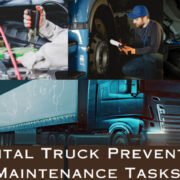Adequate sleep
Fatigue driving has serious risks.
Driving while fighting sleep can put the division in as much danger as driving under the influence, and drowsy driving will be even more dangerous as time lengthens. When a driver has difficulty concentrating, has increasingly heavy eyelids, and has difficulty keeping his or her mind awake, then he or she should stop as soon as convenient. Otherwise, your reaction time may be much slower than it should be, putting you at serious risk of an accident.
So when you feel sleepy, stop and rest promptly. Before driving, it is essential to get enough sleep and good quality sleep. In this regard, China National Heavy Duty Truck has taken a big step forward. Its Howo trucks, the HW76 model, are equipped with a 98cm extended sleeper, and HW79 is fitted with a double sleeper. Both the extended sleeper and the double sleeper provide more comfortable resting conditions for truck drivers. This can to a certain extent ensure the quality of sleep for truck drivers, thus allowing them to have sufficient sleep time and be able to put in more energy for the next day’s work.
check the performance of the truck
The performance condition of the truck itself plays a very important role in the driver’s road safety, so we should never ignore this point. Long-distance driving has this higher requirement on the performance of the truck. Before leaving, drivers should conscientiously test or check the performance of the truck, including but not limited to the following aspects:
- Is the fluid level correct?
- Do the lights work? Do the windshield wipers work?
- Are the tires in good condition and have good pressure?
- Are the brakes responsive and are the brake pads making any strange noises?
- Are there any leaks?
- Does the truck make any strange noises or movements when turning?
In a word, truck drivers must check the truck performance before departure,including fluid level, tires, lights, wipers, brakes, leaks, steering and other aspects,and it is better to ask a professional mechanic to conduct a full range of serious inspections and tests to ensure the good performance of the truck and good safety.
Truck emergency kit
Truck drivers usually have to truck out long-distance driving, in addition to ensuring adequate rest, it is also very important to plan for unforeseen moments, because people can never foresee what will happen in the future.
In order to reduce the number of accidents that may occur on the road, drivers must be prepared and an truck emergency kit with them when they are driving long distances. This emergency kit should include a spare tire filled with air, a safety cone or triangle, spare water, spare fuel, jumper leads, a small fire extinguisher, prepare a travel medical kit, an electrified safety socket and jack, a wrench that can twist the tire nut, etc. When the truck has problems, truck drivers can use the tools in the emergency kit to check and fix them according to their knowledge and experience to ensure that the truck can reach the destination and complete the task smoothly.
In addition, knowing and memorizing emergency contact numbers for areas you may pass through is an important reminder. When the emergency kit does not solve the problem, you can call the emergency contact number for help. Ensure the safety of driving on the road with these safeguards.
plan a good route
As we all know. Truck drivers usually have to make long-distance drives. Before leaving, determine the destination in advance, insert the destination into the GPS and plan a stopover, determine the road to be taken, familiarize yourself with it, and plan it well. Also, search for one or two alternate roads and familiarize yourself with them in advance so that you don’t need to make a temporary diversion in case of construction or other situations on the chosen road. The driver must do his homework on the chosen road to know the basic conditions of the road, stopping points, whether to pass through villages, etc. to prepare for the journey.
Also, it is important for truck drivers to truck up-to-date paper maps. While they are not as convenient as GPS devices or cell phones, paper maps do not lose battery or coverage and are a good backup in case other systems fail.
Maintain a safe distance
According to NHTSA, tailgating or following other vehicles too closely is the cause of 32.5 percent of crashes.
Given the prevalence of such accidents, it is important for truck drivers to be aware of the distance between their vehicles and the vehicles in front of them. When a driver is on the road, a lot can happen in a split second. The purpose of following the 3-second rule is to give drivers enough time to react to most situations that may occur in front of the vehicle.
What exactly does the “3-second rule” mean?
The “rule” means that drivers try to keep three seconds of space between themselves and other drivers. Wait for the driver in front of them to pass a road sign or other inanimate object, then start counting. It takes at least three seconds before a truck passes the same object. If the truck passes the object earlier, it means it is too close to the truck in front of it and it is time to slow down. Following the 3-second rule can greatly reduce the risk of crashing and or tailgating the truck in front of you.
It is important to note, however, that it applies primarily to ideal driving and weather conditions. If it’s snowing and the driver is driving a heavy truck, give yourself a few extra seconds. Always slow down when the weather is bad, especially if the visibility of the road is reduced. Always keep a safe distance from the vehicle in front of you.
Safe overtaking
In order to reach the destination quickly and on time, truck drivers usually choose to overtake when the vehicle in front of them is moving too slowly. However, it is important to make sure that overtaking is done in a safe manner.
On roads with multiple lanes traveling in the same direction, drivers can only change lanes when the white dividing line is broken. However, sometimes a driver may find himself or herself on a roadway with continuous (or unbroken) white lines, at which point the driver cannot change lanes to overtake unless he or she is avoiding an obstacle, passing a bicyclist, obeying a traffic control signal that applies to the first marked lane, or is pulling into or out of a special dedicated lane that allows the driver to drive. Roadways marked with center lines or dividing lines may also not be crossed for the purpose of separating traffic in opposite directions, except in rare cases. If a driver finds a single or two parallel continuous lines, or a continuous line to the left of the dotted line (so that it is closest to you), he or she must not drive over, above or to the right of the dividing line unless passing a bicyclist, turning right or making a U-turn (where permitted).
Drivers should not overtake when approaching crested or curved sections of road where they cannot see vehicles approaching from the other side. To ensure that the driver in front can see his vehicle, the driver must ensure that both side mirrors of the road train are visible at all times while following behind. When it is safe to overtake, instruct, move right and overtake. Remember that overtaking is not allowed to accelerate above the posted speed limit.
Also note that the driver may only return to the left lane after the headlights of the road train can be seen in the mirrors, so please ensure that you have sufficient time to safely overtake.
Limiting driving time and stopping regularly
Long drives can be exhausting for drivers, so ensuring quality rest and a high level of alertness is something that must be stressed countless times. For this reason, it is important to limit the driver’s driving time and to ensure that he or she can stop regularly. Ensuring that drivers have sufficient energy is achieved through a two-pronged approach.
We usually recommend taking a break every two hours for at least 15 minutes and limiting driving time to eight hours a day. Drivers can take regular short breaks as they need them, preferably before they feel tired. You can rest in the cab or get out and look into the distance to rest your eyes.
It’s a good idea to roughly plan some rest stops before you leave. Especially if the driver needs to spend the night somewhere, then be sure to plan rest stops in advance.


















Comments